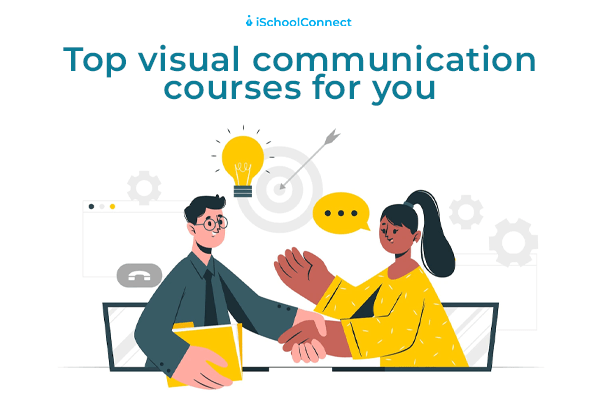Table of Contents
A book with colorful graphics has more readers than one with only text. Visual communication is a creative process that blends art and technology to visually express ideas and information, making them interactive and understandable. It has become an essential component of many sectors, including film and television, graphic illustration, online design, and so on. Pursuing one of the creative career paths will help you discover new opportunities across the globe. . While there are multiple degree programs available to learn and study various aspects of visual communication, the Bachelor of Science or BSc Visual Communication program is one of the most popular. In this blog, we will discuss universities, eligibility, and employment opportunities for visual communication course.
The term ‘Viscom’ refers to visual communication. It can also be considered a form of mass communication.. Visual aids convey messages, ideas, and information to a large group of people. This method of communication has proven to be highly effective because more people are open to visual aids.
Visual communication is a broad field. Drawing, animation and multimedia, sketching, advertising, graphic design, writing, editing, video editing, photography, film production, editing, and so on are all covered. Depending on the course (UG and PG), one can specialize in any of the above mentioned fields.
Undergraduate Courses
- B.Sc. in Visual Communication
- B.Sc. in Visual Media
- BA in Visual Communication
- Diploma in Visual Communication
- Bachelor of Design in Visual Communication
- Certificate course in Visual Communication
- BVC (Bachelor of Visual Communication)
- Bachelor of Fine Arts in Visual Media
Postgraduate Courses
- M.Sc. in Visual Communication
- M.Sc. in Visual Media
- MA in Visual Communication
- PG Diploma in Visual Communication and Merchandising
- PG Certification in Visual Communication and Merchandising
- Master of Design in Visual Communication
- Graduate Diploma in Visual Arts
- Master of Fine Arts in Visual Media
Ph.D. Programs
- Ph.D. in Visual Media and Communication
- M Phil in Visual Media and Communication
Criteria for Eligibility

The course’s eligibility requirements vary. For example, 10+2 Science stream education is necessary for the B.Sc. Visual Communication course. In the case of the BA course, a 10+2 pass in any stream is sufficient. A 10+2 pass in any stream is enough for the Diploma course and B.Sc Visual Media.
The eligibility criteria may also differ between institutes. Some institutes admit 10+2 graduates from any stream, even to Science (B.Sc.) programs!
Deserving students get admission based on their performance in board and state-specific entrance exams. Private screening tests/qualifying examinations may be available at several prestigious institutes.
Specializations
- Photography
- Videography
- Graphic Design
- Drawing
- Animation, Multimedia, and Game Art
- Web Design
- Design Management
- Advertising and Merchandising
- Editing and Writing
- Film Production and Editing
Job profiles and Career Opportunities

Visual communication provides a wide range of work prospects. Specialization determines one’s job profile to some extent. Some of the well-known job profiles available to graduates based on specialties include-
- Graphic designer
- Photographer
- TV Production professional
- Film Director and Producer
- Advertising Professional
- Animator
- Lecturer/Instructor
- Web designer
- Videographer
- Editor
- Writer
- Visual Media Manager
- Anchor/VJ
- Design Developer
Some of the places where one may find a job include
- Film Production Houses
- Digital Marketing Agencies
- Marketing Agencies
- Advertising Agencies
- TV Broadcast Groups
- Visual Communication/Media Colleges (or training institutes)
Key takeaways
- In terms of communication efficiency, visual communication outperforms verbal communication.
- One of the key benefits of visual communication is its simplicity.
- Visual materials are more appealing to the eye. It provides aesthetic satisfaction if it is very artistic.
Liked this blog? Read next: An overview of the mass communication course
FAQs
Q1. What are the 4 types of visual communication?
Answer: Animated GIFs, screenshots, videos, pie charts, infographics, and slide deck presentations are examples of visual communication.
Q2. Is graphic design the same as visual communication?
Answer: The difference between the two is so slight that it is impossible to tell them apart. Briefly put, visual communication deals with the task of communicating a message or piece of information. Graphic design, on the other hand, is a tool that visual communicators use to solve problems in illustration, typography, or photography.
Q3 Why is visual communication important?
Answer: In contrast to verbal communication, visual communication strengthens connections and aids in memory retention. The area of our brains responsible for long-term memory is what helps us remember images.






